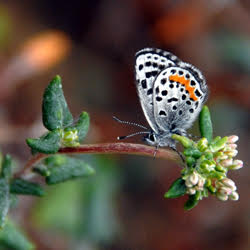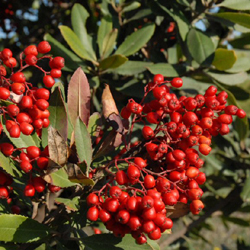Gardening with Native Plants

Dune Buckwheat (hosting male El Segundo Blue) Eriogonum parvifolium
Where To Get Your Ideas
Places to see native plants include demonstration gardens, nature preserves, specialty nurseries, arboretums and botanic gardens, as well as in books and on websites.
The South Coast Chapter maintains a native plant garden at the Point Vicente Interpretive Center in the City of Rancho Palos Verdes, and one of our Horticulture Co-Chairs designed the native plant garden at the Madrona Marsh Nature Center in the City of Torrance. Another great resource is at the Manhattan Beach Botanical Garden in the City of Manhattan Beach.
There are several areas of the South Coast Botanic Garden where you can find California Native Plants Garden Highlights and approximately 86 acres of native plants (representing 2,000 species) at the Rancho Santa Ana Botanic Garden in Claremont.
The Palos Verdes Peninsula Land Conservancy frequently hosts hikes of our local nature preserves, and docents can identify most of the native plants for you.
Please see additional links on our Plant Resources page.
Where to Buy Native Plants
Since 1984, the South Coast Chapter has hosted an annual native plant sale in conjunction with the Fall Plant Sale at the South Coast Botanic Garden. This event usually occurs on the first Saturday in October, and is announced several months in advance.
In addition, there are several retail native plant nurseries within an hour of the South Coast Chapter area, including:
Rancho Santa Ana Botanic Garden’s “Grow Native” Nursery – Claremont
Theodore Payne Foundation – Sun Valley
Tree of Life Nursery – San Juan Capistrano

Toyon, California Holly, Christmas Berry
Heteromeles arbutifolia
Getting Started
Visit a native plant supplier, or plan to attend our annual plant sale, which is an excellent opportunity to take advantage of our member’s experience and knowledge. Make your selections, and then follow the supplier’s instructions for placing and caring for your new plants. Find more information at native plant nurseries and their websites, or explore this list:
Native Plants of the Palos Verdes Peninsula That are Suitable for Gardens
With a little curiosity and research, you can broaden your plant palette. Choose plants that flower through the seasons. Fill your garden with plants that display a riot of colors, have deliciously aromatic leaves, or attract specific wildlife. Plant a themed landscape such as a rock garden or wildflower meadow. In every garden, the right environment (sun, soil, water, etc.) must be found or created for plants to thrive. It is easier and advisable to select plants that suit the site rather than to modify the site to suit the plants. Like all gardens, even established native landscapes require some routine maintenance to look their best.
Growing Conditions
Like all living things, native plants grow best under natural and familiar conditions, also known as biotic communities. Common Southern California plant communities include chaparral, coastal sage scrub and bluff, desert, freshwater and salt marsh, riparian woodland, southern oak woodland, and valley grassland. Choosing plants that are native to your plant community will help ensure their optimum health and performance.
Planting
Although most California natives can be planted at any time of year, it is best to put them in the ground during the fall and early winter. This gives them time to establish a healthy root system during the cool wet months and build the energy for new growth and stunning floral displays in spring and summer.
Watering
Many native plants can survive with minimal supplemental water once they have become established (after two to five years). Proper watering can present a challenge when first becoming acquainted with native plants. Under-watering of young native plants is a frequent cause of death, while over-watering can cause root rot and kill more established species. Some native species can maintain a healthy appearance for much of the year while being watered only 1–4 times per month. For a garden full of thriving native plants, check plant-specific watering needs from authoritative sources.
Soil
Most native plants perform better without any fertilizer. Extra nutrients push plants to grow quickly, sometimes beyond naturally supportable levels, and can shorten their life span. Mulching can be a valuable practice in low-maintenance gardening. A layer of mulch slows water evaporation, discourages weed germination, and creates a favorable environment at the soil interface for beneficial biological bacteria. Adding organic matter to soil may be necessary where development has left an infertile top layer.
Pruning
While many non-native garden plants are often pruned throughout the year to keep up with their water- and fertilizer-induced growth, for most native plants pruning once per year is sufficient. Check plant-specific pruning tips from authoritative sources as plant preferences vary. Give them room to grow by properly spacing them in your garden design. Crowded plants need more frequent pruning and care.
Adapted from CNPS Horticulture Brochure
Native Plant Gardens of the South Coast Region
Below is an interactive map of public native plant gardens. These are great places to visit to see California native plants in their mature stage in a garden setting. Some of these locations are a representation of lightly manicured habitat. Click on a flower for garden information
